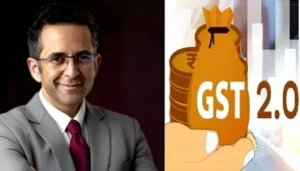The Government of India today rolled out GST 2.0, the next-generation reform announced by Prime Minister Narendra Modi from the Red Fort on Independence Day—one that could transform the landscape for small enterprises.
By cutting tax slabs to just two—5% and 18%—and eliminating the intermediate 12% and peak 28% rates, GST 2.0 simplifies compliance and reduces costs. Nearly all items in the 12% bracket now move to 5%, while most taxed at 28% drop to 18%.
This sweeping rationalisation is expected to ease the tax burden across the board, giving a powerful boost to MSMEs, startups, and entrepreneurs by lowering input costs and lightening compliance pressures.
A Two-Slab GST for Simplicity and Savings
In GST 2.0, India moved away from the previouly prevailing five-slabs (0%, 5%, 12%, 18%, 28% + cess on sin commodities) to effectively two basic slabs: 5% (merit rate) and 18% (normal rate), with a special high rate (~40%) for some sin or luxury goods such as tobacco.
This reduction would see the 28% and 12% slabs abolished altogether, compressing most goods and services into the lower two rates.
For instance, mass-consumption and basic items currently taxed at 12% – from some foods and household staples to cheap clothing- would fall to 5%, lowering their price for final customers quite considerably.
Similarly, most “aspirational” or more valuable items being charged at 28% today, like appliances (TVs, refrigerators, air conditioners), electronics, and other consumer durables, would be shifted to the 18% slab.
Few “demerit” goods (such as cigarettes or pan masala) only would be charged a new 40% instead of the existing 28%+cess regime.
Lower Tax Rates = Lower Input Costs for MSMEs
One of the greatest gains for small companies under GST 2.0 will be from reduced input expenses. When tax rates on commodities are lowered, the price of raw materials, parts, and services that companies buy can fall considerably.
By shifting almost all items from the 12% slab to 5%, most inputs on which small producers and traders depend will become less expensive.
Textiles are a case in point: under the system that prevailed, various segments of the textile value chain belonged to several slabs (raw materials such as synthetic fiber at 18%, some fabrics or apparel at 5% or 12%), thus resulting in inverted duty structures where tax on inputs exceeded tax on outputs.
Briefly, small textile units can anticipate smoother cash flows and fewer dollars held up in expectation of refunds, as inputs and outputs fall into the same low tax bracket.
Similarly, handicraft and artisan enterprises will benefit from rate reductions. Under the new scheme, a large number of handmade products would move to 5%, making them cheaper immediately.
Government sources have confirmed that tax reductions are being aimed at industries such as handicrafts, agricultural produce, and health services to spur consumption and growth.
As a matter of fact, officials themselves specifically included handicrafts among industries that will gain from the GST restructuring. Aside from individual industries, overall lowering goods from 28% to 18% will lower input prices for every business that utilizes those goods for production.
For example, a small restaurant or processing unit purchasing a refrigerator or a cold storage facility will pay 18% GST rather than 28%, so capital equipment becomes cheaper.
Simplified Compliance and Tax Returns
Tax compliance for most small businesses was a laborious exercise under the previous multi-slab GST. Deciding which GST rate to charge for every good or service might be puzzling, incorrectly designating something as 12% rather than 18% (or vice versa) threatened notices and fines.
GST 2.0’s simplified two-rate regime will cut massively into this complexity, making it much more obvious which rate should be charged. This is a huge relief for small traders who don’t possess a large tax consultancy staff.
A more straightforward rate structure translates into easier bookkeeping and invoicing, too, with fewer columns and categories to monitor in GST returns.
Conclusion: A New Era for Small Business Growth
The planned GST reforms are a major milestone, a step towards a simpler, more equitable tax system that benefits the little players as much as the big players.
By cutting most 12% goods to 5% and 28% goods to 18%, the government is directly addressing the problems that have long nagged small businesses: excessive input taxes, stifled credits, and complicated compliance.
Moreover, the two-slab structure eliminates uncertainty and instills confidence that the tax system won’t be a maze of rates to find one’s way through. As GST 2.0 is rolled out (subject to GST Council approval), MSME entrepreneurs and startup founders can expect to spend more time on innovation and growth, and less on tax issues.
In the larger scheme of things, this reform will improve India’s ease of doing business ranking and motivate more entrepreneurs to become a part of the formal economy.
Note: We are also on WhatsApp, LinkedIn, and YouTube to get the latest news updates. Subscribe to our Channels. WhatsApp– Click Here, YouTube – Click Here, and LinkedIn– Click Here.



